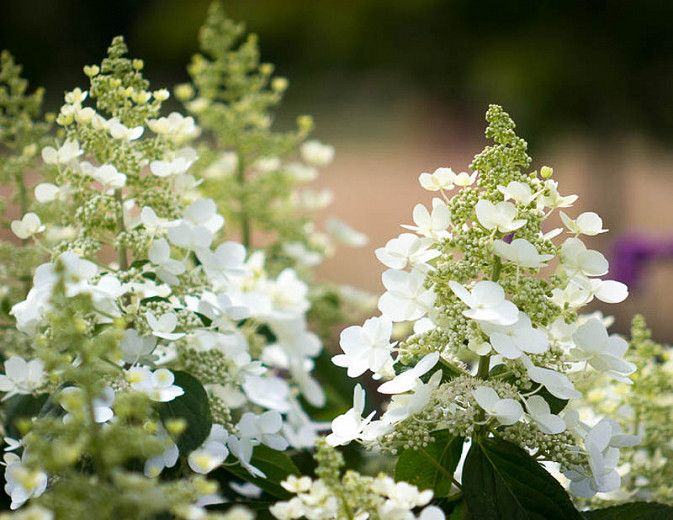Hydrangea Paniculata Tardiva: The Late Bloomer That Will Wow Your Garden
Hydrangea paniculata 'Tardiva' is a late-blooming panicle hydrangea that is known for its large, showy white flowers. It is a vigorous, upright shrub that can grow up to 8-12 feet tall. The flowers are borne in large, pyramidal panicles that can reach up to 8 inches long. The flowers start out white and gradually turn pink as they mature. 'Tardiva' hydrangeas bloom from late summer to fall, when many other plants have already finished blooming. This makes them a valuable addition to any garden, as they can provide late-season color and interest.
In addition to its beautiful flowers, 'Tardiva' hydrangeas are also relatively easy to care for. They prefer full sun to partial shade and moist, well-drained soil. They are not as sensitive to soil pH as some other types of hydrangeas, so they can be grown in a variety of soils. 'Tardiva' hydrangeas are hardy in USDA zones 3-9.
If you are looking for a late-blooming hydrangea that is easy to care for, 'Tardiva' is a great choice. It is a beautiful and versatile plant that can add a touch of elegance to any garden.
Here are some additional details about Hydrangea paniculata 'Tardiva':
- Flower color: White to pink
- Bloom time: Late summer to fall
- Height: 8-12 feet
- Spread: 6-8 feet
- Sun exposure: Full sun to partial shade
- Soil: Moist, well-drained
- Hardiness: USDA zones 3-9
How to care for Hydrangea paniculata 'Tardiva':
- Water regularly, especially during hot, dry weather.
- Fertilize in spring with a balanced fertilizer.
- Prune in late winter or early spring, before new growth begins.
- Protect from frost in cold winter climates.
Propagation:
Hydrangea paniculata 'Tardiva' can be propagated by softwood cuttings taken in early summer or by hardwood cuttings taken in winter.
Pests and diseases:
Hydrangea paniculata 'Tardiva' is generally pest- and disease-free. However, it can be susceptible to leaf spot, rust, and mildew. If you notice any of these problems, treat them with a fungicide according to the label directions.
Where to plant Hydrangea paniculata 'Tardiva':
Hydrangea paniculata 'Tardiva' can be planted in a variety of locations in the garden. It is a good choice for borders, hedges, or as a specimen plant. It can also be planted under trees or shrubs, where it will not receive full sun.
Combinations:
Hydrangea paniculata 'Tardiva' can be combined with a variety of other plants in the garden. Some good companion plants include roses, peonies, chrysanthemums, and asters. It can also be planted with evergreen shrubs or trees to provide year-round interest.
Conclusion:
Hydrangea paniculata 'Tardiva' is a beautiful and versatile plant that can add a touch of elegance to any garden. It is easy to care for and blooms late in the season, when many other plants have already finished blooming. If you are looking for a late-blooming hydrangea, 'Tardiva' is a great choice.
Hydrangea paniculata 'Tardiva' is a beautiful late-blooming hydrangea that is sure to add a touch of elegance to your garden. With its large, white flowers that slowly turn purplish-pink with age, 'Tardiva' is a sight to behold from late summer to fall.
If you're interested in learning more about 'Tardiva', I encourage you to visit . This website has a wealth of information about the plant, including its care requirements, planting instructions, and pest and disease prevention tips.
You can also find photos and videos of 'Tardiva' in bloom, as well as gardening inspiration from other 'Tardiva' enthusiasts.
FAQ of hydrangea paniculata tardiva
- What is Hydrangea paniculata tardiva?
Hydrangea paniculata tardiva is a type of hydrangea that is known for its large, late-blooming flowers. It is a deciduous shrub that can grow up to 6 feet tall and wide. The flowers are typically white or pink, but can also be blue or purple depending on the soil pH. Tardiva hydrangeas are hardy in USDA zones 4-9 and prefer full sun to partial shade.
- How do I care for Hydrangea paniculata tardiva?
Tardiva hydrangeas are relatively easy to care for. They need moist, well-drained soil and full sun to partial shade. They should be watered deeply and regularly, especially during hot, dry weather. Tardiva hydrangeas do not need to be fertilized often, but a light application of fertilizer in the spring can help promote blooming. They should be pruned in the spring, just before new growth begins.
- How far apart should I plant Hydrangea paniculata tardiva?
Tardiva hydrangeas should be planted 4-5 feet apart to allow for their mature size. If you are planting them as a hedge, you may want to plant them closer together.
- What are some common pests and diseases of Hydrangea paniculata tardiva?
Tardiva hydrangeas are relatively resistant to pests and diseases. However, they can be susceptible to aphids, scale, and powdery mildew. If you notice any pests or diseases on your plant, you can treat them with insecticidal soap or neem oil.
- How long do Hydrangea paniculata tardiva flowers last?
Tardiva hydrangeas typically bloom from late summer to early fall. The flowers can last for several weeks, depending on the weather.
Image of hydrangea paniculata tardiva
5 different images of "hydrangea paniculata tardiva" from Pinterest:
- A large, white panicle hydrangea with dark green leaves.

- A close-up of the flowers, which are bell-shaped and have a slightly wavy edge.

- A cluster of flowers in shades of pink and blue.
- A single flower in full bloom, showing off its delicate petals.

- A hydrangea bush covered in flowers, in the late summer or early fall.

Post a Comment for "Hydrangea Paniculata Tardiva: The Late Bloomer That Will Wow Your Garden"